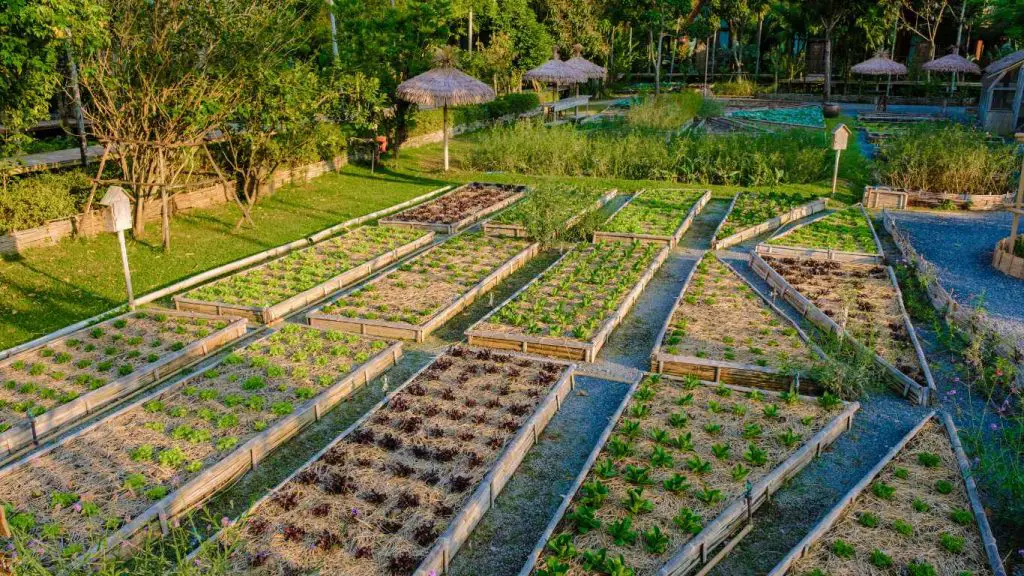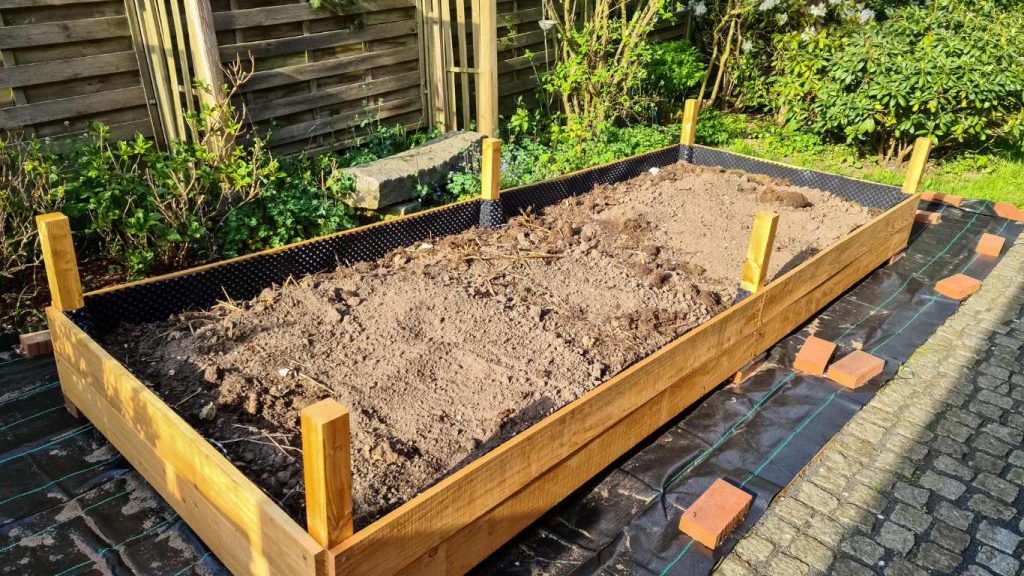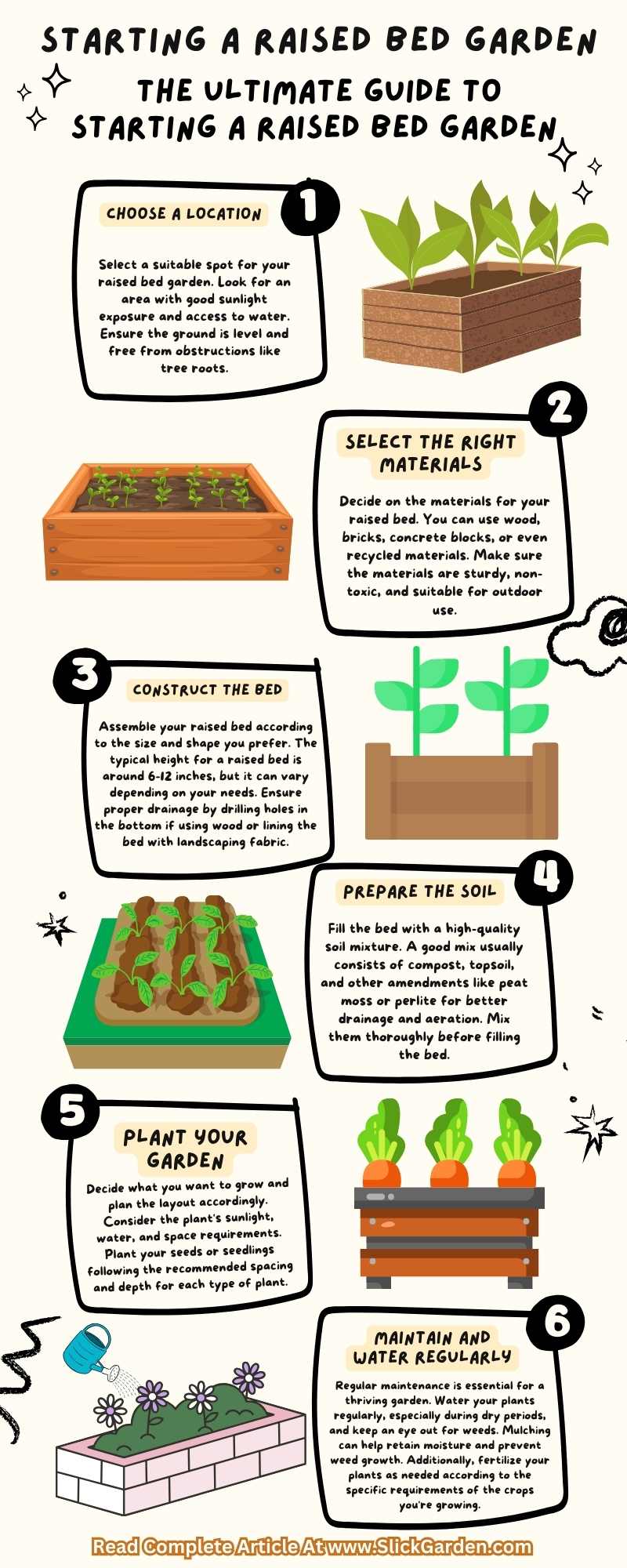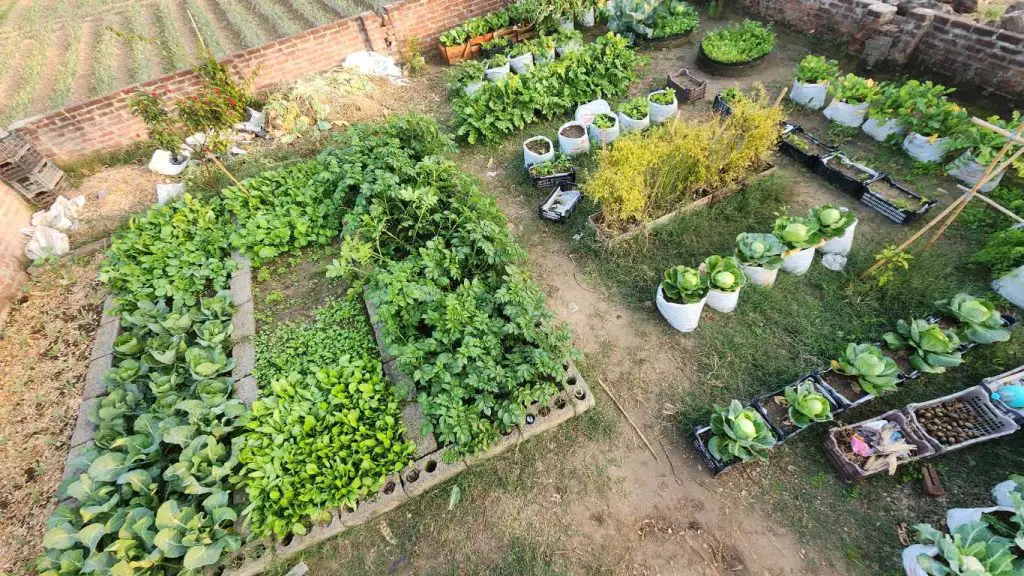We’re going to learn all about raised bed vegetable planting today. This guide will give you all the information you need to start your own beautiful garden, no matter how much experience you have or how little. Come with me as I talk about the fun, easy steps, and benefits of growing your own fresh, tasty food at home. Let’s do this fun adventure together and get our hands dirty!

What Is The Best Location For Your Raised Bed Garden?
An ideal spot for a raised bed garden is a location that gets plenty of sunlight, around 6 to 8 hours a day, and has soil that drains well. It should be conveniently reachable for maintenance, watering, and harvesting.
Take care to avoid areas that are susceptible to strong winds, as they can potentially harm delicate plants. Additionally, it’s best to steer clear of areas where water tends to accumulate, as excessive moisture can result in root rot.
In addition, it’s important to think about how close you are to a water source so that you can easily water your plants. Lastly, if you can, consider selecting a location near your home or kitchen for easy access and to promote regular maintenance and harvesting.
What Is The Best Material For Your Raised Bed Garden?
Choosing the ideal material for a raised bed garden is often a matter of personal preference, budget, and environmental factors. Cedar and redwood are commonly chosen for their inherent resistance to decay and insects, which ensures their long-lasting durability.
In addition, they have a pleasing appearance and provide a natural aesthetic to the garden. On the other hand, utilizing composite materials made from recycled plastics and wood fibers provides a durable solution that requires minimal upkeep. Constructing raised bed gardens can be made easier with the use of cinder blocks.
These structures are known for their durability, easy availability, and ability to provide great stability for your garden. These containers are perfect for holding soil and can withstand different weather conditions due to their strong construction.
How To Clean Your Site Before Making Raised Bed?
Getting a site ready for a raised bed requires a few essential steps to guarantee cleanliness at its best. Begin by removing any debris, rocks, or plants from the area.
Eradicate any unwanted plants and their roots completely, either by manually removing them or utilizing a garden hoe. Digging into the soil and removing any underlying weed roots is a helpful practice to prevent future growth.
What To Put Before Putting Soil In Raised Bed?
Prior to adding soil to a raised bed, it is crucial to establish a strong base to support your plants’ well-being. Begin by placing a barrier at the base to keep weeds out of your bed. For complete coverage, consider using either landscaping fabric or cardboard to cover the entire bottom area.
This layer is designed to prevent the growth of weeds, while still allowing water and nutrients to easily pass through. Afterward, incorporate a layer of coarse organic material such as twigs or small branches. This will help with drainage and aeration, while also gradually decomposing and enriching the soil.
How To Fill Your Raised Bed?

Start by incorporating a blend of top-notch garden soil, ideally loamy soil that has excellent drainage and is packed with nutrients, filling the bed to about half its capacity. Add a layer of compost to enhance fertility and enhance the structure of the soil. Layer the soil and compost in a straightforward manner until the bed is almost full, allowing for some settling at the top.
RELATED ARTICLES:
- Everything You Need To Know About Adding Worms In Your Raised Bed Garden
- Everything You Need To Know About Preparing A Garden Bed For Planting Vegetables
- Every Thing About Watering Your Plants In A Raised Bed Garden

15 Best Plants To Grow In Raised Beds
Lettuce
Lettuce is an important part of every salad and any dish that needs a topping, but especially burgers and sandwiches. You should check how fertile the dirt is because plants need fertilizer to grow. Don’t worry, though; all your hard work will not be wasted. You don’t need to worry too much about when the best time is for it to grow because it can do well in both fall and spring. It needs some sun, and the frame will be ready in two to three months.
Every week, you should add mulch to the ground. Adding soil will make it better. The ground has to be cool, and it needs to be watered often. Try to keep them moist, and put mulch over the dirt. If you want to keep it cool on hot days, put your raised bed somewhere that will give it shade.
ONION
You can grow onions without much trouble, but it will be even easier if you put them in a raised bed. In 100 days, you should be able to easily pick onions. Onions grow best in full sun and rich, well-drained soil. They don’t need much water because they are spring plants.
As was already said, onions are a crop that is easy to grow, but that doesn’t mean you don’t like them. This is because plants need nitrogen to grow well, so you should keep adding nitrogen fertilizer every three to four weeks.
Onions don’t need to be constantly wet, but if you water your onion trees all the time, the onions will taste better. Cover the soil with mulch and keep watering. You can tell that the onion is ready to be picked from the top. You can tell this is the right time to pick because the top is yellow.

Carrots
Because carrots have deep roots, you need to make sure that the beds are raised enough to give their roots room. Most root vegetables are grown in the ground, but if you can’t keep the right conditions for their growth, it’s better to grow them in raised beds. It is possible to keep the dirt healthy in a raised bed.
Carrots will look bad if the soil doesn’t drain well, but adding sand to the soil will help them grow because they love sandy soil. There should be about 3 to 4 inches between each carrot plant. For the best yield in the first week, keep the dirt wet. Before they are ready to eat, carrots need 70 to 80 days to grow.
SQUASH
Since summer squash can’t handle frost, it needs to be in the right amount of sunshine, have good drainage, and grow in soil that is fertile, damp, and free of weeds. Before a few weeks of last spring’s frost, when the ground has warmed up, you should put them.
You can easily plant it by spreading seeds out straight, but you can also use seedlings. Before you start planting in raised beds, mix compost into the dirt. During the growing season, I fertilized the dirt as needed. Squashes are ready to eat after two to three months.
TOMATOES
Potatoes are a food that everyone loves, especially kids. When you grow potatoes in raised beds, they are free for your home. If you give your favorite veggie full sun, rich, slightly acidic soil, and lots of water, you can use it in a lot of different ways.
You should pick the right time to plant potatoes. You should put them before the last big frost of the season because they can’t handle very cold weather. But potatoes usually take two to three months to get fully grown. Some types take a lot longer.
MINT
When you grow mint in raised beds, you won’t have any problems. It’s very simple to grow and doesn’t need much care. Since mint plants tend to grow, you can cut them off at any time. One cool thing about mints is that you can grow them from cuttings.
You can even grow these cuttings in water. You don’t have to wait until it’s time to gather, but when the leaves are still young is best. You can pick them whenever you want.
The fresh mint leaves will make your favorite foods taste better because they are used to dress things and make a lot of sauces. While hot mint tea is good for your stomach and can help with stress, mint has many other health benefits as well.
CORN
The most amazing crop that grows quickly is called, and you can grow a lot of it. There are certain things that it needs, like dirt that is very fertile, regular watering, and planting it in the spring. Corn can’t be grown inside; it has to be planted outside.
It’s possible To put Kaun in a raised bed, but it needs more care. There should be enough room between the plants. Allow Water to be given Your plants regularly; this will keep the soil wet.
BEAN
To get healthy beans, you need to do some moderate care. However, if you are a beginner, you won’t be able to deal with the bugs that attack these plants. A careful gardener is needed to take care of these plants.
Make sure the soil is well-balanced and water it often. If your bean plants can take all the nutrients from the soil, they will grow quickly. You can pick the pods when they are hard and big. If you want big beans, you should train them to grow on a trellis so they can easily climb it. You don’t need to hold up the small beans.
RADISH
If you give it regular sun and only a little water, you can pick it just one month after planting it. This makes it a good choice for beginners. This vegetable is easy to take care of and can grow in any soil.
You should leave 2 to 3 inches of space between radishes because they have deep roots. You should put your raised bed somewhere that the radish plants will get enough sun. You can also eat the reddish’s greens. The green part of the radish should be cut off and saved for cooking after it has been picked.
TOMATOES
For tomato plants, spring and summer are good times. They like raised beds and pots. Extra help is needed because tomatoes are big and will need it when they start to grow. Tomatoes come in many different types.
You ought to pick the type that can easily and quickly make yield. If you only have a small amount of space or are growing in raised beds that aren’t very big, cherry tomatoes are the best choice because they produce tasty fruit all at once.
For healthy tomatoes, you need dirt that is full of nutrients and mixed with compost and fertilizers. They also need 6 to 8 hours of full sun and to be watered regularly, especially when the baby tomatoes start to grow.
CUCUMBERS
This plant likes it hot, the dirt should be wet, and it needs a lot of nutrients. Put your raised beds somewhere that will give your plants full sun. If you mix dirt with compost and fertilizer, it will be easy for the cucumber to get all the nutrients it needs.
This crop can’t handle frost, so don’t put it when frost is likely. You can put cucumber seeds or seedlings about an inch deep. For cucumbers to taste sweet, they need to be watered regularly. If the soil is dry, it’s not good for your cucumber plants.
PEPPERS
In raised pots, it’s easy to grow pepper. Peppers come in a lot of different types, such as sweet bell peppers and hot peppers. Make sure to mix good natural fertilizer into the dirt when you’re getting your planting bed ready. Pepper is a plant that likes to be in the sun and needs good soil that drains well.
Pepper needs less water, but that doesn’t mean you shouldn’t give it water every day. Every day, you should water them. However, you can’t move them from inside to outside. You can only grow them outside. Before the last freeze, the planting has to begin. When the papers are the right size, you can cut them off with a sharp pair of scissors.
PEAS
It takes very little time for peas to grow, but they grow very quickly. Mix manure and fertilizers into the dirt before you plant the peas in raised beds. They need 4 to 8 hours of sunlight a day and regular watering.
Don’t water them too much, though, or the soil will become more wet. When you see that the pods are big enough for your needs, you can start picking them. Early in the morning is the best time to pick them, and they will taste the best.
BROCCOLI
Broccoli is an easy vegetable to grow that does well in cold weather. You should make a setting that is good for broccoli so that it grows well. Broccoli likes a lot of nutrients, so add compost and manure to the dirt to make it more fertile.
It needs to be 4.5°C (40°F) in the ground. Its leaves show if it doesn’t have enough of any mineral. For example, broccoli leaves turn yellow when there isn’t enough nitrogen in the soil. These signs help us figure out what the plant’s main problem is.
Make sure you water the plant on time. When it’s time to harvest, keep an eye on the broccoli heads to see if they are going yellow or black. This means they are past their best time to be picked.
SPINACH
Spinach grows best in cold weather, so put it in the spring or fall. You don’t have to worry about taking care of it because it is an easy food crop. But the dirt you use must drain well and not have any clay in it.
If you have never gardened before, don’t worry—this is a great crop for people who know nothing about farming. When the leaves are big enough to eat, they are ready to be picked. If not, they will taste bitter. We learned that you can try them in raised beds as well as in-ground flower beds, which is interesting.
RELATED ARTICLES:
